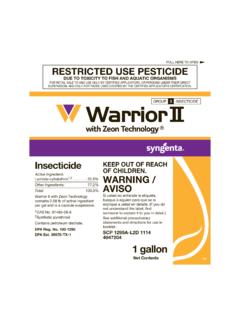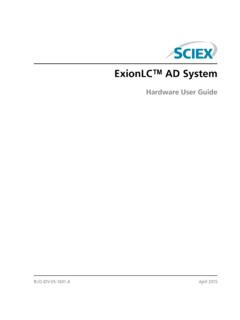Transcription of A REVIEW OF THE REFERENCE DOSE AND REFERENCE …
1 EPA/630/P-02/002F December 2002 Final Report A REVIEW OF THE REFERENCE DOSE AND REFERENCE CONCENTRATION PROCESSES Prepared for the Risk Assessment Forum Environmental Protection Agency Washington, DC REFERENCE Dose/ REFERENCE Concentration (RfD/RfC) Technical Panel Bob Benson (OPRA/Region 8) Edward Ohanian (OST/OW) Gary Foureman (NCEA/ORD) Jennifer Orme-Zavaleta (NHEERL/ORD) Lee Hofmann (PARMS/OSWER) Deborah Rice (NCEA/ORD) Carole Kimmel (NCEA/ORD)* Jennifer Seed (OPPT/OPPTS) Gary Kimmel (NCEA/ORD) Hugh Tilson (NHEERL/ORD) Susan Makris (OPP/OPPTS) Vanessa Vu (SAB Staff Office, formerly Deirdre Murphy (OAQPS/OAR) OSCP/OPPTS and NCEA/ORD) *Technical Panel Chair Technical Advisors Amy Mills, IRIS Director, NCEA/ORD Bill Wood, RAF Director, NCEA/ORD Risk Assessment Forum Environmental Protection Agency Washington, DC 20460 DISCLAIMER This document has been reviewed in accordance with Environmental Protection Agency policy and approved for publication.
2 Mention of trade names or commercial products does not constitute endorsement or recommendation for use. ii CONTENTS LIST OF TABLES .. vi LIST OF FIGURES .. vi i LIST OF ABBREVIATIONS AND vi ii PREFACE ..x EXECUTIVE SUMMARY .. xi ii 1. INTRODUCTION, PURPOSE, AND SCOPE .. 1- 1 2. REVIEW OF THE CURRENT USE OF ACUTE, SHORT-TERM, AND LONGER-TERM REFERENCE VALUES .. 2- 1 REVIEW OF CURRENT LESS-THAN-LIFETIME REFERENCE VALUES .. 2- 1 Acute REFERENCE Exposure (ARE) Methodology .. 2- 1 Acute Exposure Guidelines (AEGL) Program .. 2- 3 Office of Pesticide Programs (OPP) Procedures for Setting Acut e and Int ermedi ate RfDs .. 2- 5 Office of Water (OW) Health Advisories (HAs) .. 2- 6 Agency for Toxic Substances and Disease Registry (ATSDR) Mini mal Risk Leve ls (MRLs) .. 2- 9 SUMMARY OF CURRENT METHODS FOR SETTING ACUTE, SHORT-TERM, AND LONGER-TERM REFERENCE VALUES.
3 2- 9 RECOMMENDATION .. 2- 11 3. REVIEW OF TESTING GUIDELINES WITH RESPECT TO LIFE STAGE ASSESSMENT .. 3- 1 EVALUATION OF CURRENT GUIDELINE TESTING PROTOCOLS .. 3- 2 Exposures and Endpoints Related to General Toxicity Testing .. 3- 4 Acute and Short-Term Toxicity Studies .. 3- 6 Subchronic and Chronic Toxicity Studies .. 3- 9 Exposures and Endpoints Related to Evaluation of Reproductive Toxicity .. 3- 10 Overview of Tests .. 3- 10 Gaps in Life Stage of Assessment .. 3- 13 Gaps in Assessment Endpoints .. 3- 14 Gaps in Duration/Latency Assessment .. 3- 14 Exposures and Endpoints Related to Evaluation of 3- 15 Overview of Tests .. 3- 15 iii CONTENTS (continued) Gaps in Life Stage of Assessment .. 3- 17 Gaps in Assessment Endpoints .. 3- 18 Gaps in Duration/Latency Assessment .. 3- 18 Exposures and Endpoints Related to Evaluation of Immunotoxicity.
4 3- 19 Overview of Tests .. 3- 19 Gaps in Life Stage of Assessment .. 3- 22 Gaps in Assessment Endpoints .. 3- 22 Gaps in Duration/Latency Assessment .. 3- 23 Exposures and Endpoints Related to Evaluation of Cardiovascular Toxicity 3-23 Overview of Tests .. 3- 23 Gaps in Life Stage of Assessment .. 3- 23 Gaps in Assessment Endpoints .. 3- 25 CONCLUSIONS AND RECOMMENDATIONS .. 3- 26 3- 27 29 OPTIONS FOR ALTERNATIVE TESTING APPROACHES .. 3- 31 Alternative Acute Toxicity Testing Protocol .. 3- 31 Alternative Chronic Toxicity Testing Protocols .. 3- 33 The Expanded Chronic/Carcinogenicity Study .. 3- 33 The Unified Screening 3- 35 4. FRAMEWORK FOR SETTING ACUTE, SHORT-TERM, LONGER-TERM, AND CHRONIC REFERENCE VALUES .. 4- 1 DEFINITIONS OF EXPOSURE DURATIONS FOR USE IN SETTING REFERENCE VALUES .. 4- 2 PROPOSED CHANGES IN THE REFERENCE VALUE DEFINITIONS.
5 4- 4 CHARACTERIZATION OF THE EXTENT OF THE HEALTH-RELATED DATABASE FOR SETTING REFERENCE VALUES .. 4- 7 REVIEW of Studies .. 4- 7 Adequacy of Studies .. 4- 8 Issues to be Considered in Characterizing the Database for Risk Assessment .. 4- 11 The Weight-of-Evidence 11 Use of Human and Animal Data in Risk Assessment .. 4- 12 Characterization of Effects in Potentially Susceptible Subpopulations .. 4- 15 Characterization of the Extent of the Database .. 4- 17 Extent of the Database .. 4- 20 DERIVATION OF REFERENCE VALUES .. 4- 21 iv CONTENTS (continued) Sample REFERENCE Values and Selection of Endpoints to Use as the POD for REFERENCE Values .. 4-22 Dose Adjustment for Duration of Exposure .. 4-24 Duration Adjustment Procedures for Inhalation Exposures to Continuous-Exposure Scenarios .. 4-24 Duration Adjustment for Inhalation Developmental Toxicity Studies A Current Exception.
6 4-25 Duration Adjustment for Acute REFERENCE Values Discontinuous Scenarios of 24 Hours or Less .. 4-26 Derivation of a HEC or a HED .. 4- 29 PBPK Models and Derivation of HEDs and HECs: Estimating Internal Dose .. 4-30 Default Procedures and Derivation of HECs from the RfC Methodology: Derivation and Application of DAFs .. 4-32 HECs and Children A Special Case? .. 4-34 Deriving a HED for Oral and Dermal Exposure Use of BW3/4 as a Cross-Species DAF .. 4-35 Other Issues .. 4- 37 Application of Uncertainty/Variability Factors .. 4-38 Recommendations for Application of UFs .. 4-40 Interspecies UF .. 4-42 Intraspecies UF .. 4-42 LOAEL-to-NOAEL UF .. 4-44 Database 4-44 Subchronic-to-Chronic-Duration UF .. 4-45 Modifying Factor (MF) .. 4-46 Future Directions .. 4-47 Chemical-Specific Adjustment Factors (CSAFs).
7 4-47 Probabilistic Approaches .. 4-48 Summary of Key Points from the Case Studies .. 4-49 5. APPENDIX A: ISSUES RAISED BY THE 10X TASK FORCE .. A-1 APPENDIX B: CASE STUDIES EVALUATING AND SELECTING HEALTH ENDPOINTS FOR DERIVING REFERENCE VALUES ..B-1 GLOSSARY .. G-1 REFERENCES ..R-1 v LIST OF TABLES Table 2-1. Duration definitions used for various REFERENCE values .. 2-10 Table 2-2. Uncertainty/safety factors for various REFERENCE values .. 2-12 Table 3-1. Approximate age at equivalent life stages in several species .. 3-3 Table 3-2. Systems/endpoints evaluated by routine toxicity guideline testing protocols .. 3-5 Table 4-1. Factors for evaluation of the weight of evidence regarding the likelihood of effects in humans .. 4- 14 Table 4-2. Factors for evaluating of evidence regarding identification and characterization of susceptible subpopulations.
8 4-17 Table 4-3. DAFs based on BW3/4 for various species .. 4-36 Table 4-4. BMDLs, ingested dose, and RfDs for various endpoints from the Faroe Islands, New Zealand, and the NRC integrative analysis .. 4-51 vi LIST OF FIGURES Figure 3-1. Exposures and endpoints related to general toxicity evaluations .. 3-7 Figure 3-2. Exposures and endpoints related to reproductive evaluations .. 3-11 Figure 3-3. Exposures and endpoints for neurotoxicity evaluations .. 3-16 Figure 3-4. Exposures and endpoints for immunotoxicity evaluations .. 3-20 Figure 3-5. Exposures and endpoints related to cardiovascular evaluations .. 3-24 Figure 3-6. Alternative acute toxicity protocol .. 3-32 Figure 3-7. Expanded chronic/carcinogenicity Figure 3-8. Unified screening study .. 3-36 Figure 4-1. Concentration-by-duration plot showing the effect of the exponent in the Cn x T = k on extrapolation across time.. 4-27 Figure 4-2.
9 Current and proposed generalized procedures for deriving HECs or HEDs from animal exposures .. 4- 31 vii LIST OF ABBREVIATIONS AND ACRONYMS ACE II Angiotensin converting enzyme II ADI Acceptable Daily Intake AEGL Acute exposure guideline level ARE Acute REFERENCE exposure ATSDR Agency for Toxic Substances and Disease Registry AUC Area under the curve BMC Benchmark concentration BMCL Benchmark concentration lower confidence limit BMD Benchmark dose BMDL Benchmark dose lower confidence level BMR Benchmark response CatReg Categorical Regression (software) CFSAN Center for Food Safety and Nutrition CNS Central nervous system CSAF Chemical-specific adjustment factor DAF Dosimetric adjustment factor DNT Developmental neurotoxicity ECE-1 Endothelin-converting enzyme-1 ELISA Enzyme-linked immunosorbent assay FDA Food and Drug Administration FQPA Food Quality Protection Act FIFRA Federal insecticide , Fungicide.
10 And Rodenticide Act GD Gestational day GLP Good Laboratory Practices HA Health Advisory HEC Human equivalent concentration HED Human equivalent dose IPCS International Programme on Chemical Safety IRIS Integrated Risk Information System LOAEL Lowest-observed-adverse-effect-level MF Modifying factor MOE Margin of exposure MRL Minimal risk level NAAQS National Ambient Air Quality Standards NCEA National Center for Environmental Assessment NK Natural Killer NOAEL No-observed-adverse-effect-level OAR Office of Air and Radiation OECD Organisation for Economic Cooperation and Development OPP Office of Pesticide Programs viii LIST OF ABBREVIATIONS AND ACRONYMS (continued) OPPTS Office of Prevention, Pesticides, and Toxic Substances OSWER Office of Solid Waste and Emergency Response OW Office of Water P Parental PAD Population adjusted dose PBPK Physiologically-based pharmacokinetic model PFC Plaque-forming cell PND Postnatal day POD Point of departure PRA Plasma renin activity RDDR Regional deposited dose ratio RGDR Regional gas dose ratio RfC REFERENCE concentration RfD REFERENCE dose SAB Science Advisory Board SPF Specific pathogen free SRBC Sheep Red Blood Cells TSCA Toxic Substance Control Act TWA Time-weighted average UF Uncertainty factor ix PREFACE The Environmental Protection Agency (EPA) Risk Assessment Forum was established to promote scientific consensus on risk assessment issues and to ensure that this consensus is incorporated into appropriate risk assessment guidance.











